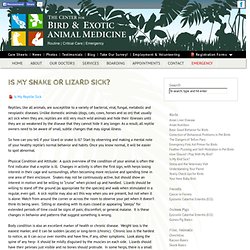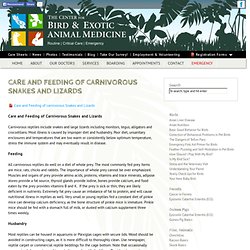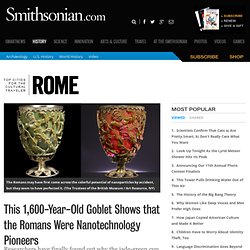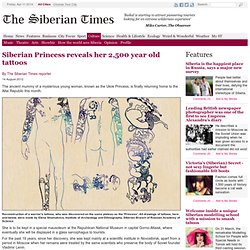

Archaeologists Hunt for the Tomb of Genghis Khan. His end didn't begin heroically.

The Mongolian ruler simply fell off his horse. His hands and legs must have lost their strength. The greatest mystery of the Inca Empire was its strange economy. The Center for Bird & Exotic Animal Medicine, Bothell WA. Is My Reptile Sick Reptiles, like all animals, are susceptible to a variety of bacterial, viral, fungal, metabolic and neoplastic diseases.

Unlike domestic animals (dogs, cats, cows, horses and so on) that usually act sick when they are, reptiles are still very much wild animals and hide their illnesses until they are so weakened by the disease that they cannot hide it any longer. As a result, all reptile owners need to be aware of small, subtle changes that may signal illness. So how can you tell if your lizard or snake is ill? Start by observing and making a mental note of your healthy reptile’s normal behavior and habits. Physical Condition and Attitude: A quick overview of the condition of your animal is often the first indicator that a reptile is ill. Body condition is also an excellent marker of health or chronic disease. The Center for Bird & Exotic Animal Medicine, Bothell WA. Care and Feeding of carnivorous Snakes and Lizards Care and Feeding of Carnivorous Snakes and Lizards Carnivorous reptiles include snakes and large lizards including monitors, tegus, alligators and crocodilians.

Most illness is caused by improper diet and husbandry. Poor diet, unsanitary enclosures and temperatures that are too warm or consistently below optimum temperature, stress the immune system and may eventually result in disease. Feeding All carnivorous reptiles do well on a diet of whole prey. Husbandry Most reptiles can be housed in aquariums or Plexiglas cages with secure lids.
Heat rocks should not be relied upon to warm the enclosure. CRYPTOSPORIDIA. Cryptosporidiosis in Lizards by: Marcia McGuiness © Golden Gate Geckos 2009 Purpose:

This 1,600-Year-Old Goblet Shows that the Romans Were Nanotechnology Pioneers. The colorful secret of a 1,600-year-old Roman chalice at the British Museum is the key to a supersensitive new technology that might help diagnose human disease or pinpoint biohazards at security checkpoints.

The glass chalice, known as the Lycurgus Cup because it bears a scene involving King Lycurgus of Thrace, appears jade green when lit from the front but blood-red when lit from behind—a property that puzzled scientists for decades after the museum acquired the cup in the 1950s. The mystery wasn’t solved until 1990, when researchers in England scrutinized broken fragments under a microscope and discovered that the Roman artisans were nanotechnology pioneers: They’d impregnated the glass with particles of silver and gold, ground down until they were as small as 50 nanometers in diameter, less than one-thousandth the size of a grain of table salt.
The original fourth-century A.D. A time traveller’s guide to medieval 14th-century shopping. The poet WH Auden once suggested that, in order to understand your own country, you need to have lived in at least two others.

But what about your own time? By the same reckoning, you need to have experienced at least two other centuries. This presents us with some difficulties. But through historical research, coming to terms with another century is not impossible. We can approach the past as if it really is ‘a foreign country’ – somewhere we might visit. What medieval Europe did with its teenagers. Image copyright Getty Images Today, there's often a perception that Asian children are given a hard time by their parents.

But a few hundred years ago northern Europe took a particularly harsh line, sending children away to live and work in someone else's home. Fashion and beauty secrets of a 2,500 year old Siberian 'princess' from her permafrost burial chamber. 'Goodbye... 'Reconstruction of a burial scene of Ukok Princess, with both women dressed in traditional Pazyryk clothes.

All drawings, here and below, were made by Elena Shumakova, Institute of Archeology and Ethnography, Siberian Branch of Russian Academy of Science We recently exclusively revealed the extraordinary tattoos on the mummy of a woman aged approximately 25 years old preserved in her ice-clad wooden coffin high in the Altai Mountains. Her story and our pictures of her ancient - yet modern-looking - body art captivated the world and was read in The Siberian Times in no less than 165 countries, while also being followed up by many other news outlets.
Siberian princess reveals her 2,500 year old tattoos. She is to be kept in a special mausoleum at the Republican National Museum in capital Gorno-Altaisk, where eventually she will be displayed in a glass sarcophagus to tourists.

For the past 19 years, since her discovery, she was kept mainly at a scientific institute in Novosibirsk, apart from a period in Moscow when her remains were treated by the same scientists who preserve the body of Soviet founder Vladimir Lenin. Mapping Emotions On The Body: Love Makes Us Warm All Over : Shots - Health News. People drew maps of body locations where they feel basic emotions (top row) and more complex ones (bottom row).

Hot colors show regions that people say are stimulated during the emotion. Cool colors indicate deactivated areas.